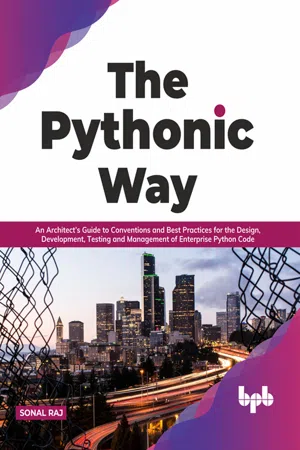
The Pythonic Way
An Architect's Guide to Conventions and Best Practices for the Design, Development, Testing, and Management of Enterprise Python Code
- English
- ePUB (mobile friendly)
- Available on iOS & Android
The Pythonic Way
An Architect's Guide to Conventions and Best Practices for the Design, Development, Testing, and Management of Enterprise Python Code
About This Book
Learn to build and manage better software with clean, intuitive, scalable, maintainable, and high-performance Python code.
Key Features
? Comparative analysis of regular and Pythonic coding constructs.
? Illustrates application design paradigms for Python projects.
? Detailed pointers on optimal data processing and application design.
? Highlights accepted conventions for testing and managing production code.
Description
'The Pythonic Way' acquaints you with Python's capabilities beyond basic syntax. This book will help you understand widely accepted Pythonic constructs and procedures, thus enabling you to write reliable, optimized, and modular applications.You'll learn about Pythonic data structures, class and object creation, and more. The book then delves into some of Python's lesser-known but incredibly powerful functionalities such as meta-programming, decorators, context managers, generators, and iterators. Additionally, you'll learn how to accelerate computations by using Pandas Series and Dataframes. You will be introduced to various design patterns that work well with Python applications. Finally, we'll discuss testing frameworks and best practices for testing, packaging, launching, and publishing applications in production environments.This book will empower you as you transition from beginner or competitive Python coding to industry-standard Python software development. Intermediate Python developers will gain a deeper understanding of the language's nuances, enabling them to create better software.
What you will learn
? Understand common practices for writing scalable and legible Python code.
? Create robust and maintainable production codebases for time and space performant applications.
? Master effective data processing practices and features like generators and decorators to improve complex computations on large datasets.
? Get familiar with Pythonic design patterns for secure, large-scale applications.
Who this book is for
This book is a valuable reference manual for novice and intermediate programmers and data scientists to learn about Pythonic standards and conventions. For beginners, this book will get you started with Pythonic thinking. This book will serve as a guide to fine-tune your skills beyond syntax and help build robust Python applications for intermediate Python coders.
Table of Contents
1. Introduction to Pythonic Code
2. Pythonic Data Structures
3. Classes and OOP Conventions
4. Python Modules and Metaprogramming
5. Pythonic Décorators and Context Managers
6. Data Processing Done Right
7. Iterators, Generators, and Coroutines
8. Python Descriptors
9. Pythonic Application Design and Architecture
10. Effective Testing for Python Code
11. Production Code Management
About the Authors
Sonal Raj is an engineer, mathematician, data scientist, and Python evangelist from India, who has carved a niche in the financial services domain. He is a Goldman Sachs and D.E. Shaw alumnus who currently heads the data analytics and research efforts for a high-frequency trading firm.He holds a dual master's degree in Computer Science and Business Management and is a former research fellow of the Indian Institute of Science. His areas of research range from image processing, real-time graph computations to electronic trading algorithms and data science. He is a doctoral candidate at the Swiss School of Business Management, Geneva. Over the years, he has implemented low latency platforms, trading strategies, and market signal models. With more than a decade of hands-on experience, he is a community speaker and a Python and data science mentor to newcomers in the field. LinkedIn Profile: https://www.linkedin.com/in/sonalraj/
Blog Link: https://www.sonalraj.com/
Frequently asked questions
Information
CHAPTER 1
Introduction to Pythonic Code
Structure
- Importance of clean Python code
- Writing better comments, docstrings, and annotations.
- Naming and code layout in Python
- Control structures in Python
- Clean Python code patterns
- Code quality enforcement tools
Objectives
- Understanding the common practices of writing scalable and legible code.
- Using constructs like docstrings, comments, and basic tools for maintainable production codebases.
- Understanding some of the lesser-known features about structuring Python code.
The importance of clean Python code
- Consistent code: With time, you get used to reading through code of a certain format. Having uniform formats of code within an organisation is of utmost importance for scalability in the long term, and making the onboarding of new developers relatively easy. Learning and maintenance becomes simpler when the code layout, naming convention, and documentation, among other features, is identical across all the repositories maintained across the firm.
- Greppable code: Imagine a scenario where you are trying to grep a variable. Now the variable can occur in assignment statements, or as named arguments in function arguments. If we want to differentiate between the two in order to refine our search, what options do we have?
$ grep -nr "name=" ../validate.py:23: name=user_name,$ grep -nr "name =" ../validate.py:20: user_name = get_username()Adding comments to your code
- A maximum of 72 – 80 characters should be the limit of the comment line.
- Complete sentences in camel-case is preferred.
- Developers and Reviewers should ensure that comments are updated when code is changed to avoid future confusion.
Block comments
Table of contents
- Cover Page
- Title Page
- Copyright Page
- Dedication Page
- About the Author
- About the Reviewer
- Acknowledgements
- Preface
- Errata
- Table of Contents
- 1. Introduction to Pythonic Code
- 2. Pythonic Data Structures
- 3. Classes and OOP Conventions
- 4. Python Modules and Metaprogramming
- 5. Pythonic Decorators and Context Managers
- 6. Data Processing Done Right
- 7. Iterators, Generators, and Coroutines
- 8. Python Descriptors
- 9. Pythonic Design and Architecture
- 10. Effective Testing for Python Code
- 11. Production Code Management
- Index